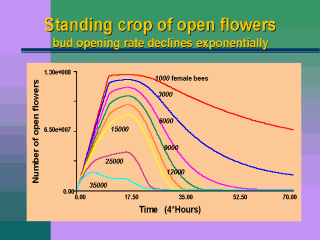







Click any image in the slide to see a larger version.
Scroll down to read accompanying notes. |
 |
Slide 17 of 21
Notes: 
(Model insights:) I ran the model over a hypothetical season for a series of bee population
sizes and found that the standing crop of open flowers over time fit a pattern
very close to what I had been observing in the field. Standing crop increases
rapidly to a peak, then decreases more slowly. The peak standing crop is lower
as the number of introduced bees increases. In addition, the time it takes to
completely pollinate the field decreases as the number of introduced bees
increases. This was precisely what growers had been describing to me: more
bees means faster pollination. This is the advantage to using a large number
of bees to pollinate the crop. It decreases the time to complete pollination.
Many growers try to put out enough bees to pollinate flowers as quickly as
they come into bloom during the peak of bloom. That of course means they run
out of flowers sooner. (The values on the axes above for number of open flowers and for time are only
very rough estimates. They could vary depending on the initial values put into
the model. More important is the shape of the curves that are generated in the
model, i.e., the pattern of standing crop over time.)
To see a practical application of this conclusion go to "A
test to determine if you have enough bees in your field", slide show
Part 3.
Strickler, K. 1997. Flower production and pollination in Medicago
sativa L. Grown for seed: model and monitoring studies. In, K.W.
Richards, ed. Proc. Intíl Symp. on Pollination Acta Horticulturae
437, ISHS pp. 109-113. Fig. 4
Alfalfa is an indeterminate bloomer, i.e., it continues to bloom as long as conditions are appropriate
and the fruits do not mature. Read about the implications of
indeterminate blooming in my essay Squash,
Beans, and Deadheading Flowers.










![]()